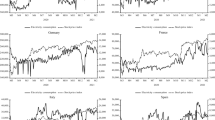Abstract
GDP is the most important and widely studied macroeconomic variable. It indicates the state of an economy and is used as a measure of the economic strength of a country. Due to its comprehensive nature, calculating GDP takes a great deal of work and is often revised over time. This has led to the common practice of forecasting GDP using econometric models. This paper introduces a new method for estimating GDP using a unique data set of options whose values are determined by the levels of GDP and the GDP growth rate. The option is market priced which makes it distinct since it is available daily, subject to no revisions and aggregates the market’s opinion about GDP. These option implied values for GDP and GDP growth rate are similar to the concept of implied volatilities. We show that this option improves the GDP growth rate forecasts by 21% compared to conventional econometric models.

Source: Eurostat and calculations

Source: Eurostat and calculations

Source: Eurostat and calculations

Source: Eurostat and calculations
Similar content being viewed by others
Notes
https://www.frbatlanta.org/cqer/research/gdpnow [last accessed: June 12, 2020].
For a complete description of the warrant, please read the Invitation Memorandum dated February 24, 2012 issued by the Hellenic Republic. In this paper we refer to this document as “PSI.” http://www.pdma.gr/greekbonds/index.php/2012-05-28-15-51-31/2012-05-28-15-52-10/2012-05-28-15-54-7/2012-05-28-15-55-55/2012-05-28-16-01-51/category/27-exchange-offer-memorandum?download=431:exchangeoffermemorandum [last accessed: November 23, 2018].
For the exact definition of the term “Real” see p. 53 of PSI.
For more information, see Consiglio and Zenios (2018).
The EUROSTAT reference code is: tec00001/Greece [last accessed: July 20, 2018].
In our analysis, we scale the GDP level by 10,000.
We are using GDPRPCHYA@GRC.Q from CapitalIQ since Eurostat provides only annual figures.
For the quarterly p, we use the average daily market price of the warrant for quarter.
From 2021 and onwards, a scheduled payment will be offset by a prior negative growth rate. For the sake of simplicity, our calculation does not include this (potential) adjustment.
The complete schedule of the threshold values and the notional amounts can be found on p. 53 of the PSI document.
We also conducted regressions using G or g differences. Results reported a statistically insignificant relationship.
Since the warrant has non-linear payments, we are including an exponential term. We would like to thank Mark Kritzman for his valuable comment.
The exact payment range is from 2015 to 2042, and the exact payment date is every October 15. For simplicity, we assume that the payment date is the last day of Q3.
See p. 53 of PSI.
See Hyndman et al. (2017).
Anonymous reviewer suggested that we compare the warrant’s information set with other high-frequency macroeconomic variables. We tested two economic indicators obtained from Eurostat; Production in Industry (PI) and Labor Input in Services (LIS). Both variables are calculated quarterly and are seasonal and calendar adjusted. We then regress these variables on lagged basis with GDP similar to Eq. 14. We found that PI is insignificant. We found LIS is significant; however, the sign of the variable was negative over the entire period although we would expect that LIS is positively correlated with GDP. Further investigation showed that during the downturn (2011–2014), the sign was negative and positive during the recovery (2014–2018).
Anonymous reviewer was concerned about endogeneity. We found no statistically significant evidence.
We conducted alternative ANOVA tests with or without intercept, lags and lagged differences. We found that the best fit for g, GS and gS is the simple AR(1) models.
See Haug (2007) for pricing barrier options.
We are using the same technique Bachelier (1900) introduced.
Results are not sensitive to this assumption.
We use a rolling average of the historical five-year correlation between G and g. Results are not sensitive to this assumption.
The percent of the Original Notional Amount in Table 4 is defined in the PSI p. 52.
See pp. 51–52 of the PSI. The G Index Percentage complies with both the restrictions of the maximum payment and the minimum value.
The complete schedule of the threshold values and the notional amounts can be found on p. 53 of the PSI document.
The complete schedule of the threshold values and the notional amounts can be found on p. 53 of the PSI document.
We assume that payments are made at the end of the third quarter.
\(S_{0,j}^{l}\), \(S_{0,j}^{r}\) are the last actual G and g observations.
We thank Darwei Kung for providing comments on earlier pricing models we used.
For more information see “The monetary policy of the ECB” (2011, p. 7).
Diebold and Mariano (1995).
See Consiglio and Zenios (2018).
References
Acalin, J. 2018, Growth—Indexed Bonds and Debt Distribution: Theoretical Benefits & Practical Limits. Working Paper 18-7, Peterson Institute for International Economics.
Alexopoulos Y. et al. 2012, Greece Debt Exchange. Credit Swiss, Fixed Income Research.
Aksu, C. and D. Guarino. 2012. Greek PSI 2—Valuation and Timeline. Barclays Capital Interest Rates Research.
Ali, A. and M. Dualeh. 2003. Interest Rates Derivatives: An Introduction to the Pricing Caps and Floors. www.yieldcurve.com.
Andersson, D. et al. 2004. Caps, Floors and Collars. Malardalen University, Analytical Finance II—MT1470.
Andong, W. 2013. Modern Pricing of Caps. M.Sc. Thesis, University of Amsterdam.
Bachelier, L. 1900. Theory of Speculation. Annales scientifiques de l’ Ecole Normale Superieure 3 (17): 21–86.
Batori, P. et al. 2012. Greece—Trading after the PSI. Morgan Stanley Research Europe.
Barr, D., O. Bush, and A. Pienkowski. 2014. GDP-Linked Bonds and Sovereign Default. Working Paper No. 484, Bank of England.
Black, F. 1976. The Pricing of Commodity Contracts. The Journal of Financial Economics 3 (1–2): 167–179.
Bowman, J., and P. Naylor. 2016. GDP-Linked Bonds. Bank of Austria: International Department.
Borensztein, E. and P. Mauro. 2002. Reviving the Case for GDP-Indexed Bonds. IMF Policy Discussion Paper. PDP/02/10.
Carnot N. and S. Summer. 2017. GDP-Linked Bonds: Some Simulations on EU Countries. Discussion Paper 073, European Commission, Directorate—General for Economic and Financial Affairs.
Cao, Y. 2012. GDP Warrant Design for Greek Debt Restructuring. Master Thesis, Tufts University.
Cecchetti, S. and K. Schoenholtz. 2017. GDP-Linked Bonds: A Primer, Money and Banking website.
Clearstream Banking Luxemburg. 2012. Hellenic Republic—PSI Questions and Answers. Document Number: 6641.
Chamon M. and P. Mauro. 2005. Pricing Growth—Indexed Bonds. IMF Working Paper.
Consiglio, A., and S. Zenios. 2018. Pricing and Hedging GDP-Linked Bonds in Incomplete Markets. Journal of Economic Dynamics and Control 88: 137–155.
Diebold, F.X., and R.S. Mariano. 1995. Comparing Predictive Accuracy. Journal of Business and Economic Statistics 13: 253–263.
Destais, C. 2017. Are State-Contingent Sovereign Bonds the Solution to Avoid Government Debt Crisis? CEPII Policy Brief.
Dickey, D., and W. Fuller. 1979. Distribution of the Estimators for Autoregressive Time Series with a Unit Root. Journal of the American Statistical Association 74: 427–431.
Dritsaki, C. 2015. Forecasting Real GDP Rate Through Econometric Models: Am Empirical Study from Greece. Journal of International Business and Economics 3 (1): 13–19.
European Central Bank. 2011. The Monetary Policy of the ECB, 7–8.
Fratzscher, M., C. Steffen, and M. Rieth. 2014. GDP-Linked Loans for Greece. DIW Economic Bulletin.
Griffith-Jones S. and K. Sharma. 2006. GDP Indexed Bonds: Making it Happen. DESA Working Paper No. 21.
Haug, E. 2007. The Complete Guide to Option Pricing Formulas, 2nd edn. New York, NY: McGraw-Hill Education.
Hellenic Republic. 2012. Invitation Memorandum Dated 24 February 2012.
Hyndman, R. et al. 2017. Forecasting Functions for Time Series and Linear Models, CRAN.
Jovanovic, B. and M. Petrovska. 2010. Forecasting Macedonian GDP: Evaluation of Different Models for Short-Term Forecasting. Working Paper, National Bank of the Republic of Macedonia.
Joy, M. 2012. Sovereign GDP-Linked Bonds: Design, Investor Response and Open Bonds. Ad Hoc Working Group on GDP-Linked Bonds, Bank of England.
Joy, M. 2015. Bank of England Workshop on GDP Linked Bonds: Making it Happen. Bank of England.
Kat, Harry M. and Ronald C. Heynen. 1996a. Brick by Brick. Risk Magazine, 9(6).
Koliavras, A. 2014. GDP-Linked Bonds and Their Diversification Benefits, Financial Economics. New York: Erasmus University Rotterdam.
Korn, R. and S. Müller. 2009. Getting Multi-dimensional Trees into a New Shape. University of Kaiserslautern.
Kopf, C. 2017. The Case for GDP-Linked Securities. BMCG meeting, European Central Bank.
Maity, B., and B. Chatterjee. 2012. Forecasting GDP Growth Rates of India: An Empirical Study. International Journal of Economics and Management Sciences 1 (9): 52–58.
Marcellino, M. 2007. A Comparison of Time Series Models for Forecasting GDP Growth and Inflation. www.researchgate.net, 1–32.
Mitchel, J. 2009. Where are We Now? The UK Recession and Nowcasting GDP Growth Using Statistical Models. National Institute Economic Review 209 (1): 60–69.
Miyajima, K. 2006. How to Evaluate GDP-Linked Warrants: Price and Repayment Capacity. IMF Working Paper.
Ning, W., Kuan-Jiang, B. and Y. Zhi-fa. 2010. Analysis and Forecast of Shaanxi GDP Based on the ARIMA Model, Asian Agricultural Research. USA-China Science and Culture Media Corporation, vol. 2(01), January.
Önder, Y. 2017. GDP—Indexed Bonds in Perpetuity and Sovereign Default, Completed Manuscript. yasinkursat.weebly.com.
Richardson, A., Mulder, T., and T. Vehbi. 2018. Nowcasting New Zealand GDP Using Machine Learning Algorithms. CAMA Working Paper 47/2018.
Ruban, O., Poon, S., and K. Vonatsos. 2008. GDP Linked Bonds: Contract Design and Pricing, SSRN.
Ruban, O. Poon, S. and L. Vitiello. 2014. Pricing GDP Linked Securities, SSRN.
Schinckus, C. 2013. How to Value GDP-Linked Collar Bonds? An Introductory Perspective. Theoretical Economics Letters 3: 152–155.
Shahini, L., and S. Haderi. 2013. Short Term Albanian GDP Forecast: One Quarter to One Year Ahead. European Scientific Journal 9 (34): 198–208.
Shiller, R. 2018. Making the Case for Sovereign GDP—Linked Bonds. Project Syndicate.
Ubide, A., and E. Yeyati. 2015. GDP-Linked Bonds: Can Argentina’s Failure Become Greece’s Success?. Washington, DC: Peterson Institute for International Economics.
Xafa, M. 2014. Sovereign Debt Crisis Management: Lessons from the 2012 Greek Debt Restructuring. CIGI Papers.
Zettelmeyer, J., C. Trebesch, and M. Gulati. 2013. The Greek Debt Restructuring: An Autopsy. Economic Policy 28 (75): 513–563.
Zhang, H. 2013. Modeling and Forecasting Regional GDP in Sweden Using Autoregressive Models. Working Paper, Högskolan Dalarna University, Sweden.
Acknowledgements
We would like to thank Mark Kritzman, CFA, Darwei Kung, Yan Xu, Stavros Zenios, QWAFAFEW Boston August 2018 meeting, the Northfield 30th Annual Research Conference and the 9th Paris Financial Management Conference participants, Ioannis Branikas and Aristeidis Raftapostolos, anonymous and blind reviewers for their comments and suggestions.
Author information
Authors and Affiliations
Corresponding author
Additional information
Publisher's Note
Springer Nature remains neutral with regard to jurisdictional claims in published maps and institutional affiliations.
Rights and permissions
About this article
Cite this article
Ntantanis, H., Pohlman, L. Market implied GDP. J Asset Manag 21, 636–646 (2020). https://doi.org/10.1057/s41260-020-00176-z
Revised:
Published:
Issue Date:
DOI: https://doi.org/10.1057/s41260-020-00176-z
Keywords
- GDP
- GDP-linked securities
- Implied GDP
- Forecasting GDP
- Nowcasting
- Bivariate probability distribution
- Option pricing




